Embark on a fascinating exploration of Alabama’s avian wonders with our comprehensive guide. This Ultimate Guide highlights the 38 most common birds found throughout the Yellowhammer State, offering valuable insights into their habitats, behaviors, and unique characteristics.
Whether you’re a seasoned birder, a nature enthusiast, or simply curious about Alabama’s diverse birdlife, this guide provides a captivating journey through the rich avian tapestry that graces this southern state. Don’t forget to get your FREE birdwatching checklist for Alabama to enhance your birdwatching experience!
Table of Contents
- 1 Most Common Birds in Alabama
- 1.1 Northern Cardinal
- 1.2 Mourning Dove
- 1.3 Carolina Wren
- 1.4 Northern Mockingbird
- 1.5 Blue Jay
- 1.6 Red-bellied Woodpecker
- 1.7 Tufted Titmouse
- 1.8 Carolina Chickadee
- 1.9 American Crow
- 1.10 Eastern Bluebird
- 1.11 House Finch
- 1.12 Downy Woodpecker
- 1.13 Eastern Towhee
- 1.14 American Robin
- 1.15 Red-winged Blackbird
- 1.16 Brown Thrasher
- 1.17 Eastern Phoebe
- 1.18 Yellow-rumped Warbler
- 1.19 Chipping Sparrow
- 1.20 Pine Warbler
- 1.21 American Goldfinch
- 2 Frequently Asked Questions
- 3 Author
Most Common Birds in Alabama
Northern Cardinal
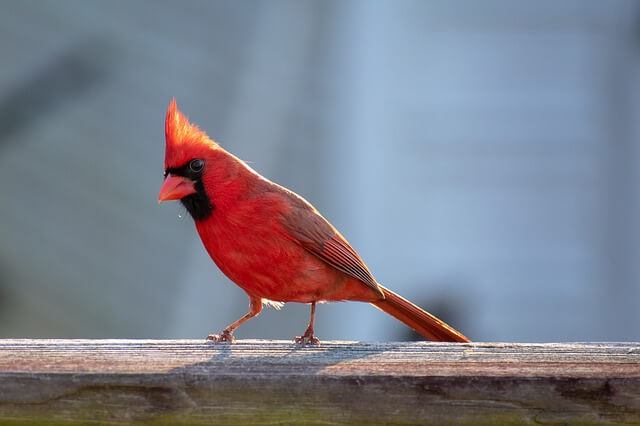
The Alabama breeding population is primarily found in the state and in the counties of Blount, Marshall, Greene, Pike, Sumter, Webster, and Etowah. They prefer to dwell in small open areas such as marshes, swamps, woodlands, brushlands, and open fields where they will often nest in hollowed-out trees or any other natural hiding place.
You can also see the Northern Cardinals in their natural habitat in the National Parks. The best time for viewing this species is in the spring and early summer.
They usually migrate from their winter quarters in Canada to the warmer states of Alabama, where they spend the summer in flight. During this time, you are going to be able to witness a display of amazing colors as they move about their territory to search for a suitable place to nest.
- Frequency: 62.26%
- Color: Mostly red with a black mask on the face
- Habitat: woodlands, gardens, parks, backyards, and wetlands
- Range: USA, Canada, Mexico
- Size: 8.2 – 9.3″ inches
- Weight: 33 – 65 grams
- Diet: Fruits, berries, and insects (grasshoppers, beetles, snails, cicadas)
- Family: Cardinalidae
- Genus: Cardinalis
Related Posts:
Mourning Dove
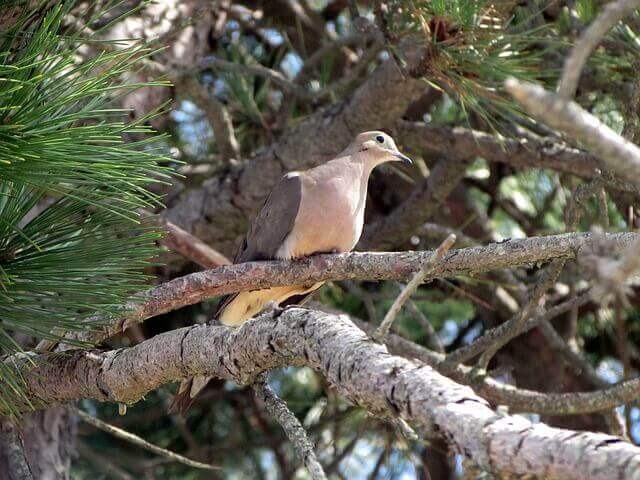
The Mourning Dove is part of the Dove family Columbidae. The bird is commonly referred to as the mourning bird, the rain bird, and colloquially as the mourning dove. It is the third most common of North American birds, with about ten to fifteen breeding pairs in the entire country.
It is commonly found in most parts of the country but is more common in the southern part of the continent, including the coastal states of South Carolina, Georgia, Alabama, Mississippi, Tennessee, Kentucky, Illinois, Michigan, Ohio, Oklahoma, New Mexico, Arkansas, Louisiana, Florida, and Texas.
- Frequency: 49.05%
- Color: Light gray-brown and lighter and pinkish below. The wings have black spots.
- Habitat: Open habitats, urban areas, farms, prairie, grassland, wooded area
- Range: USA, Canada, Mexico, Central America, Greater Antilles
- Size: 12″ inches length
- Weight: 112 – 170 grams
- Diet: Rapeseed, corn, millet, safflower, sunflower seeds, pokeberry, sesame, and wheat.
- Family: Columbidae
- Genus: Zenaida
Related Post: Facts About Mourning Doves – 10 Things You Need To Know!
Carolina Wren
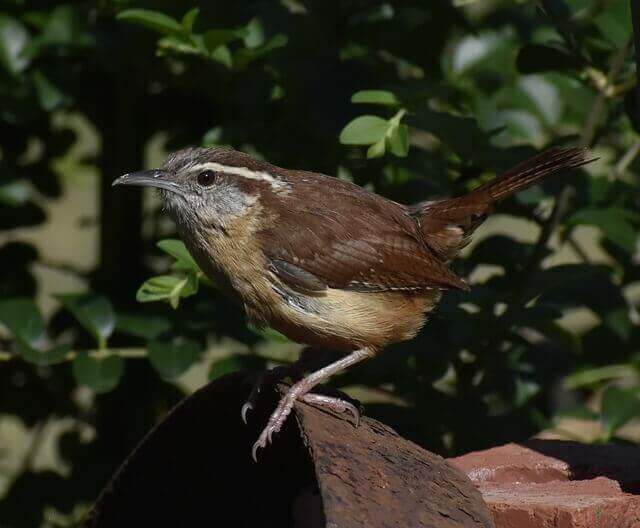
The Carolina Wren is a widespread species of small wren, which is an inhabitant in most parts of the central and western US of America, particularly the far north, east, and south-east of the US of America. In North America it is found from Alaska down to southernmost parts of Georgia, Tennessee and Alabama.
These birds are native to the forests and thick brush along coasts and rivers of central and western US of America. In Europe they are commonly found in Switzerland. The birds are also found in India. They are sometimes found in Japan as well.
- Frequency: 47.09%
- Color: Reddish-brown upper and buff-orange color under, with a white chin, throat. White stripe on the eyebrow.
- Habitat: woodlands, gardens, parks, backyards, and wetlands
- Range: USA, Canada, Mexico
- Size: 5.0 – 5.5″ inches long
- Weight: 18 – 23 grams
- Diet: Fruits, berries seeds, and insects (Caterpillars, beetles, true bugs, grasshoppers, crickets, spiders, millipedes, snails)
- Family: Troglodytidae
- Genus: Thryothorus
Related Post: How to Attract Wrens to your Backyard? (Expert’s Guide)
Northern Mockingbird
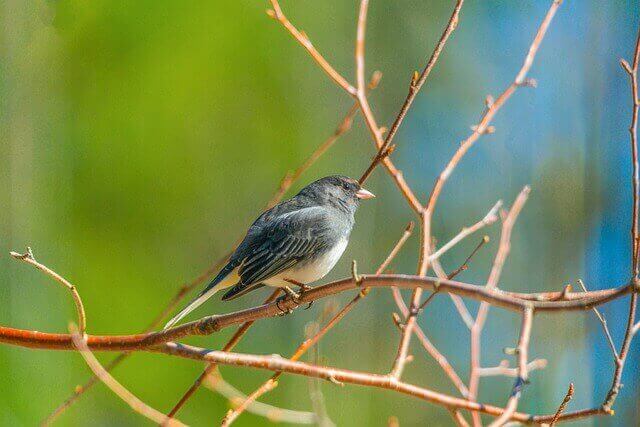
The Northern Mockingbird is a common and familiar bird in North America. It has a wide range that covers the southern parts of Canada, the eastern United States, Mexico, and Central America. The habitat of this species ranges from urban to rural areas, as well as suburbs and farms.
Mockingbirds are omnivores that feed on insects such as ants, beetles, caterpillars, grasshoppers and flies which they catch on the ground or sometimes in flight during summer months but rely more heavily on fruits and berries during winter months. These birds migrate south for winter to avoid the cold temperatures at higher latitudes like North America’s northern states.
- Frequency: 46.86%
- Color: Gray upper with white underparts. Black and white wing bars.
- Habitat: Forested areas, parks, and gardens
- Range: Southeastern Canada, USA, Northern Mexico, Cayman Islands, Greater Antilles
- Size: 8.0 – 11″ inches long
- Weight: 40 – 58 grams
- Diet: Berries, fruits, seeds, arthropods, earthworms, and occasionally lizards
- Family: Mimidae
- Genus: Mimus
Related Post: How to Attract Mockingbirds to your Yard? (Expert Tips)
Blue Jay
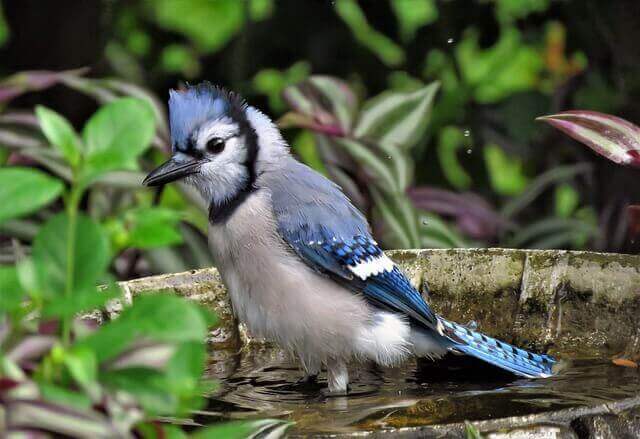
The Blue Jay is a common bird in North America, ranging from Alaska to Florida. They are also found in southern Canada and as far north as Minnesota. In the winter months, it migrates southward towards Mexico and California. Blue Jay’s habitat is found in deciduous forests, suburbs, and mixed woodlands throughout the United States.
The jays have also been spotted living on agricultural land and on mountain slopes with a variety of coniferous trees such as spruce, fir, pine, and hemlock. The diet of the blue jay consists mainly of insects such as grasshoppers, beetles, caterpillars, ants and earthworms; berries; acorns; fruit such as cherries or crab apples; nuts such as hazelnuts or walnuts.
- Frequency: 44.98%
- Color: Blue crest on the head, wings, back, and tail, and has a white face and belly
- Habitat: Deciduous and mixed forests, mixed woodlands, backyards, parks
- Range: Southern Canada, Eastern and Central United States, Florida and Texas
- Size: 8 – 12″ inches
- Weight: 70 – 100 grams
- Diet: Nuts, seeds, caterpillars, grasshoppers, and beetles
- Family: Corvidae
- Genus: Cyanocitta
Related Posts:
- How to Attract Blue Jays to your Yard?
- Do Blue Jays Migrate? The Truth
- What do Blue Jay Eat – All The Facts
Red-bellied Woodpecker
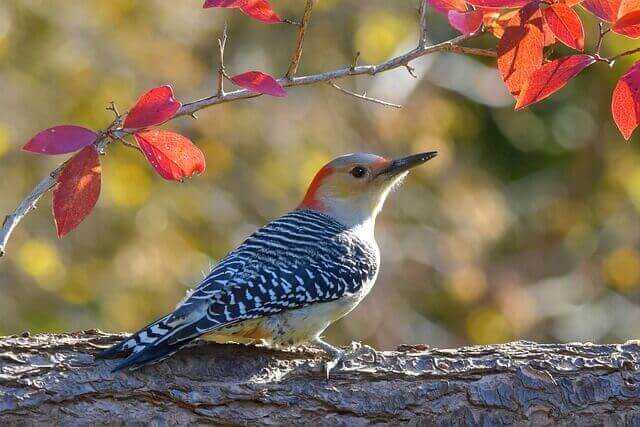
The red-bellied woodpeckers are small woodpeckers of the genus Picidae. It breeds mostly in the mid-west, ranging as far east as northern Mexico and as far west as California. This species of woodpeckers is known for its colorful songs, which make it an attractive bird to watch. This bird is so widely distributed across the country that in the early 1960s it was given the name “The Red-Bellied Woodpeckers.”
In its native habitat it is found mainly on large trees, particularly cedars, but also on large trees and limbs such as eucalyptus and oak. Woodpeckers are great at making nests. Some nests can even be more elaborate than others. These nests can be found in hollow logs or tree stumps, as well as underneath leaves, shrubs and grasses.
- Frequency: 38.81%
- Color: Gray on body and face and underparts. Black and white pattern on wings, back, and tail.
- Habitat: Forests, backyards
- Range: Southern Canada, Eastern United States, Florida
- Size: 9 – 10.6″ inches long
- Weight: 56 -91 grams
- Diet: Insects, tree frogs, eggs of small birds, oozing sap, and small fish.
- Family: Picidae
- Genus: Melanerpes
Related Post: How to Attract Red-bellied Woodpeckers to your Yard?
Tufted Titmouse
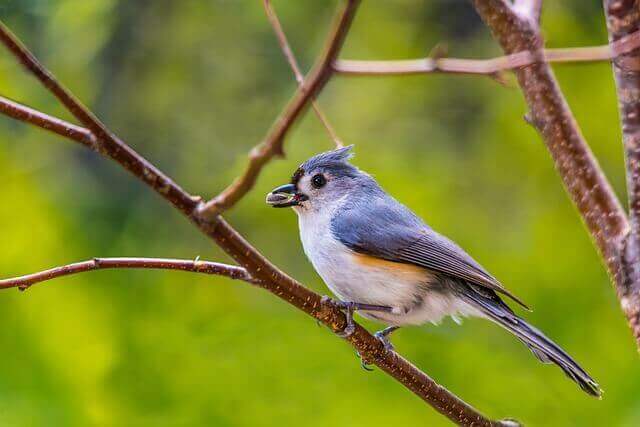
The Tufted Titmouse is a common, small bird that is found in the Eastern United States. The Tufted Titmouse’s range includes southeastern Canada and Maine, west to central Texas and north through Minnesota. Their habitat consists of brushy edges, shrubby fields, open woodlands, suburban gardens with shade trees or large evergreens, parks and college campuses.
Tufted Titmice are most commonly found in deciduous or mixed forests with trees, often near water sources such as rivers or lakes. Their diet consists of seeds, insects, berries, fruits and occasionally eggs. The migration pattern of the Tufted Titmouse includes a seasonal northward movement during winter months with some birds remaining south for summer before migrating again northward in late autumn.
- Frequency: 38.41%
- Color: Gray upper, white front, a tufted gray crest on the head
- Habitat: Deciduous forests, river basin, backyards, swamps
- Range: Canada, USA, and Mexico
- Size: 5.5 – 6.4″ inches
- Weight: 18 – 26 grams
- Diet: Nuts, insects, berries, seeds small fruit, and snails
- Family: Paridae
- Genus: Baeolophus
Related Post: How to Attract Tufted Titmouse to my Yard
Carolina Chickadee
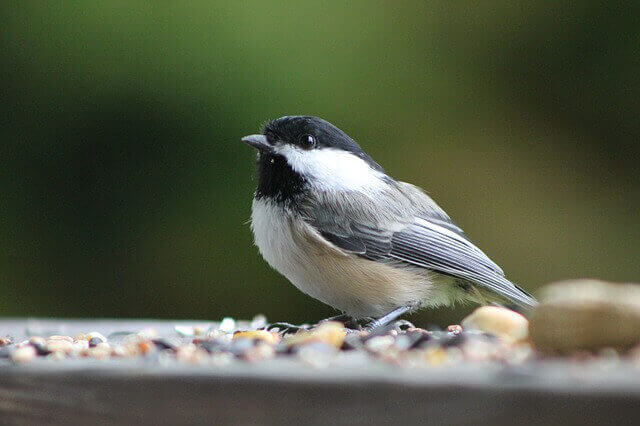
The Carolina Chickadee is a small songbird native to the eastern United States. The range of this bird includes North America, and its habitat can vary from temperate forests to mixed deciduous-coniferous forests.
It prefers woodland habitats with dense understory vegetation, but it also inhabits orchards, gardens, parks and urban areas. This species primarily eats insects such as beetles and caterpillars during the summer months (April-October), but in winter it will eat acorns, berries, and even fruit.
- Frequency: 38.24%
- Color: Black cap and throat with white cheeks. Light gray wings, back, and tail.
- Habitat: Deciduous forests, suburbs, parks, backyards
- Range: USA ( Texas, Florida, New Jersey, and Kansas)
- Size: 4.5 – 5.1″ inches long
- Weight: 9 – 12 grams
- Diet: Insects, berries, seeds
- Family: Paridae
- Genus: Poecile
Related Post: Carolina Chickadees – 9 Best Ways To Attract Them Fast!
American Crow
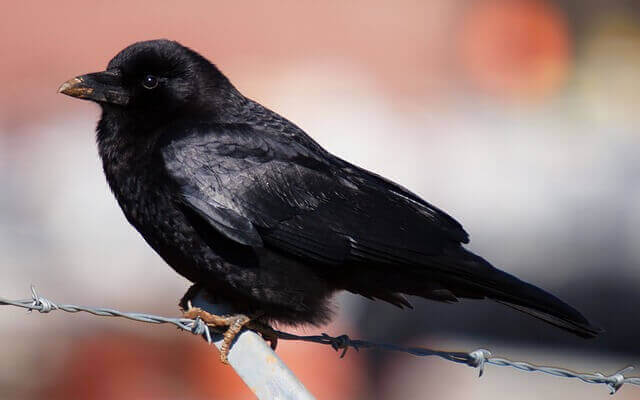
The American crow is a common bird in North America. The diet of the American Crow consists mainly of animal material such as insects, earthworms, mollusks, amphibians, reptiles and small mammals but also includes plant matter such as corn cobs or nuts. Crows live in all sorts of habitats: urban areas, agricultural fields, forests, deserts and the arctic tundra.
They migrate south for the winter months to avoid cold weather or find food sources that might not be available during the colder seasons. American crows can be found across most of North America year-round, with populations residing near the southern states.
- Frequency: 34.40%
- Color: Black
- Habitat: Open country, farms, parks, woodlands, towns, cities
- Range: Canada, USA, Mexico
- Size: 16 – 21″ inches
- Weight: 315 -620 grams
- Diet: invertebrates, carrion, seeds, eggs fish, grains, mice, frogs, and other small animals.
- Family: Corvidae
- Genus: Corvis
Related Posts:
Eastern Bluebird
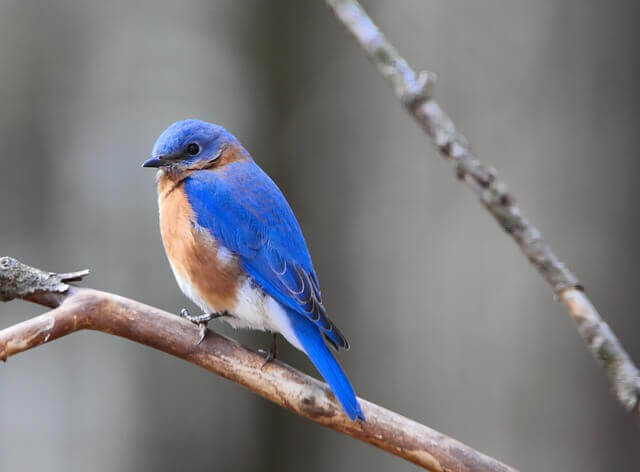
The Eastern Bluebird is a small, mostly insectivorous bird that ranges from Canada to Central America. They are abundant in North America, and they can inhabit a variety of habitats including agricultural fields, woodland edges or residential areas with mature trees.
Eastern Bluebirds eat mainly feed on insects, berries, fruit, seeds and other foods such as spiders or caterpillars. When the birds migrate south for winter, they tend to find areas of habitat with lots of berries.
- Frequency: 30.47%
- Color: A Blue head, back, and wings. reddish-brown breast
- Habitat: Open woodlands, farmlands, and orchards.
- Range: Southern Canada to the Gulf states, East of the Rockies and south to Arizona to Nicaragua
- Size: 5.5 – 7.1″ inches in length
- Weight: 20 – 33 grams
- Diet: insects and other invertebrates
- Family: Turdidae
- Genus: Sialia
Related Posts:
- How to Attract Eastern Bluebirds to your Yard (Explained)
- 60 Fun Facts About Eastern Bluebirds (You Didn’t Know!)
- 9 Best Birdhouses for Bluebirds (Top Picks for 2022)
House Finch
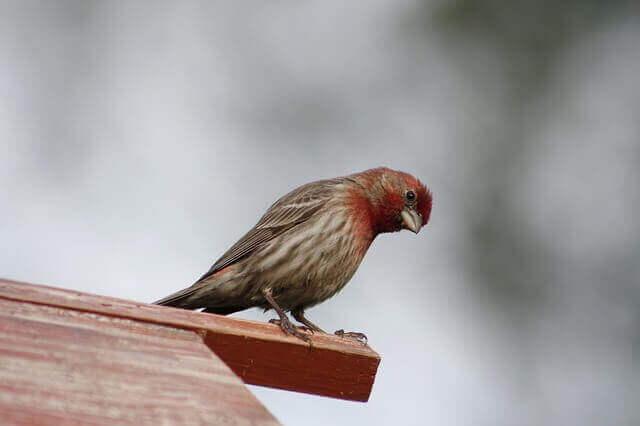
House Finches are a common sight in the United States and Canada. They breed mainly from east of the Rocky Mountains to North Carolina, as well as up into central Alaska and northern Canada. The house finch’s range includes most of the eastern United States westward to Minnesota, along with Colorado and New Mexico.
Their habitat is varied, but they typically inhabit open areas with scattered trees or shrubs such as pastures, grasslands, parks and yards where food can be found. Their diet consists mostly of seeds and grains, which they eat on or near the ground where they find them. House finches also eat some insects and occasionally fruit or nectar when it is available for them.
- Frequency: 27.13%
- Color: Reddish face and upper breast, brown streaks on back, belly, and tail.
- Habitat: urban and suburban areas, backyards, edges, yards, and parks
- Range: Canada, USA, Mexico
- Size: 5 – 6″ inches
- Weight: 16 – 27 grams
- Diet: Aphids, grains, seeds, berries, nettle, dandelion, sunflower
- Family: Fringillidae
- Genus: Haemorhous
Related Post: How to Attract House Finch to your Yard
Downy Woodpecker
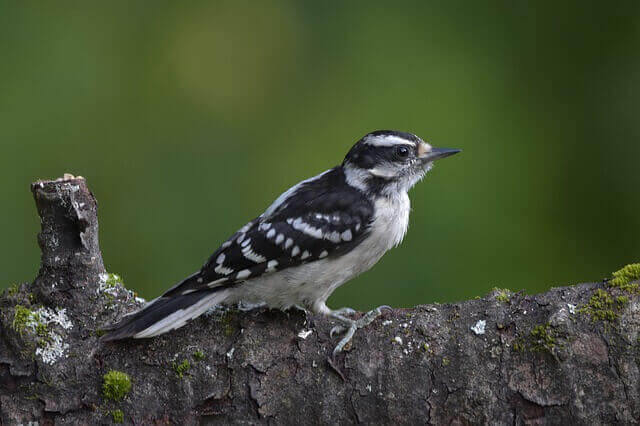
The Downy Woodpecker is a type of bird in the Picidae family. It can be found throughout North America, Central America and into northern South America. The Downy Woodpeckers are among the most common woodpeckers in North America and they have been seen as far north as Alaska, south to Costa Rica and west to California.
They inhabit deciduous forests but also live in coniferous forests that contain hardwoods or pines. The diet of these birds consists mainly of ants, termites, other insects and seeds, but they will also eat some berries or nuts as well
- Frequency: 26.15%
- Color: Black with a white throat, belly, and back. White spots on wings
- Habitat: Deciduous forests and thickets, roadside, grasslands, backyards, parks
- Range: Canada, USA, and Mexico
- Size: 5.5 – 7.1″ inches in length
- Weight: 20 – 33 grams
- Diet: Mostly insects and beetles and ants, also gall wasps, caterpillars
- Family: Picidae
- Genus: Dryobates
Related Post: How to Attract Downy Woodpeckers to Your Yard? (Easy!)
Eastern Towhee
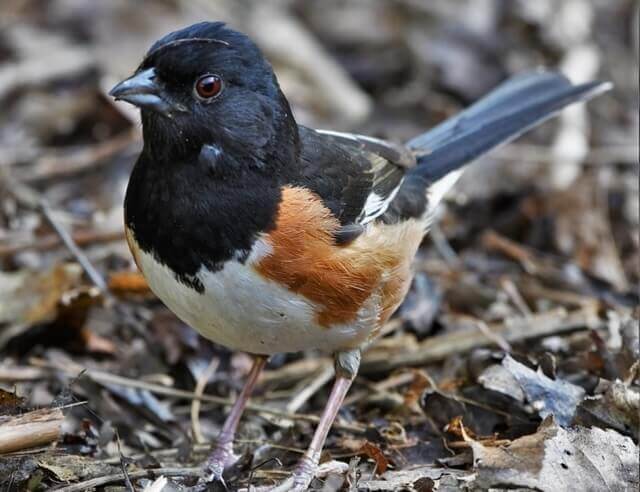
The Eastern Towhee is a member of the passerine family, and it’s known for its melodic song. This songbird is found in the eastern and central United States. The Eastern Towhee’s habitat ranges from wet areas such as bogs, swamps, marshes and wooded areas near watercourses or rivers to dry fields with scattered trees or brushy vegetation.
They will also nest on the ground if necessary, but they typically prefer to nest in trees or shrubs, high up off the ground to avoid predators. Its diet consists of insects, seeds and berries which it forages on the ground.
- Frequency: 25.65%
- Color: A Black head, upper body, and tail, reddish-brown sides, a white belly, and a long dark tail with white edges
- Habitat: Deciduous forests and thickets, roadside, grasslands, backyards, parks
- Range: Eastern USA and Canada
- Size: 6.8 – 9.1″ long
- Weight: 32 – 53 grams
- Diet: insects and other invertebrates occasionally small amphibians, snakes, and lizards
- Family: Passerellidae
- Genus: Pipilo
Related Post: How to Attract Towhee to your Backyard? Expert Tips!
American Robin
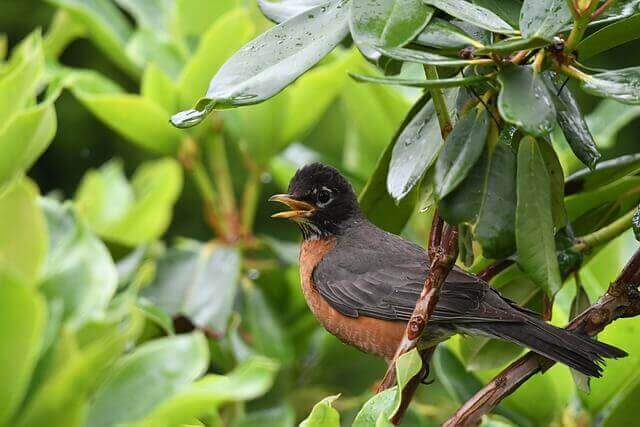
The American Robin is a migratory songbird native to North America. It ranges from Canada to Panama and breeds throughout the continent. The American Robin can be found in various habitats, including woodlands, marshes, farmland and residential areas. The American Robin’s diet consists of invertebrates such as insects and earthworms, as well as fruit and berries.
It also consumes small amphibians, reptiles, mammals or other birds it may find on its territory during breeding season. These birds migrate north for winter during November or December and return south again during April or May. Migration pattern: The migration of these birds takes place primarily at night.
- Frequency: 23.66%
- Color: Mostly brown on the back with an orange-colored breast
- Habitat: Wooded areas, backyards, parks, fields
- Range: USA, Canada, Mexico
- Size: 12 – 16″ inches in length
- Weight: 72 – 95 grams
- Diet: Fruits, berries, and insects (earthworms, beetles, caterpillars
- Family: Turdidae
- Genus: Turdus
Related Post: Interesting American Robin Fun Facts
Red-winged Blackbird
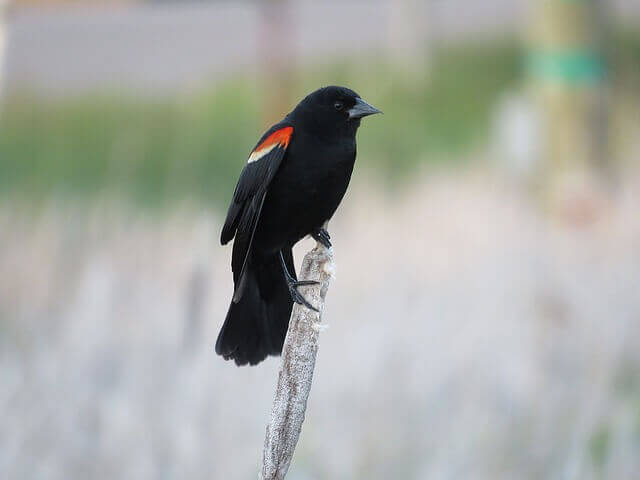
The Red-winged Blackbird is a common North American bird that can be found in wetlands, marshes and other wetland habitats. They have a wide range across the continent, with some breeding populations in Canada and wintering populations down to Central America. In North America they are most commonly found near water sources such as ponds, rivers or lakes but will also live near man-made water sources like golf courses.
This species eats seeds, insects, small animals and fruits such as grapes and berries when they are available. They migrate south during wintertime so that their habitats can be warmer with more food sources than there would be in Canada or the northern United States.
- Frequency: 21.72%
- Color: All black with red patches on shoulder and a yellow wing bar
- Habitat: Deciduous forests, conifers, roadside, rivers, backyards, parks
- Range: North America, Central America
- Size: 6.7 – 7.1″ inches length
- Weight: 41.5 – 65 grams
- Diet: Seeds and insects (butterflies, dragonflies, moths, frogs, worms, spider, snails, carrion, flies.)
- Family: Icteridae
- Genus: Agelaius
Brown Thrasher
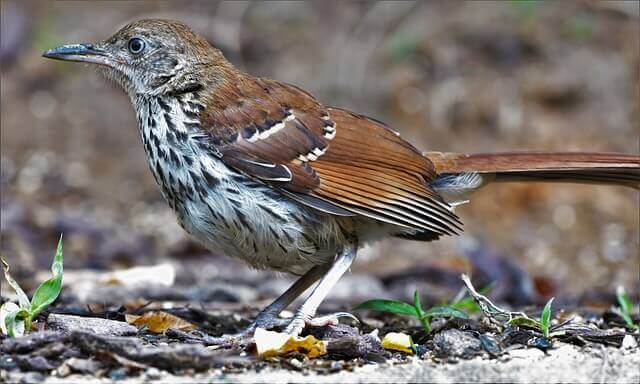
The Brown Thrasher is a small bird found in North America. The brown thrasher’s range includes the eastern and central United States, with their western limit on the Gulf Coast. They inhabit open areas like fields, meadows, woodlands, parks and gardens. The diet of the brown thrasher mainly consists of insects that they find on the ground or catch in flight while singing at an exposed perch close to trees or bushes.
These birds will also eat berries from shrubs and other trees. It lives year-round in the eastern half of the United States and southern Canada, but migrates to warmer climates during winter months.
- Frequency: 21.45%
- Color: reddish-brown upper with a white chest with patterned markings on its chest
- Habitat: Woodland edges, thickets and dense brush, backyards, parks
- Range: USA and Canada, and Mexico
- Size: 9.0 – 12″″ inches length
- Weight: 60 – 90 grams
- Diet: Insects, berries, nuts and seeds, earthworms, snails, lizards and frogs
- Family: Mimidae
- Genus: Toxostoma
Eastern Phoebe
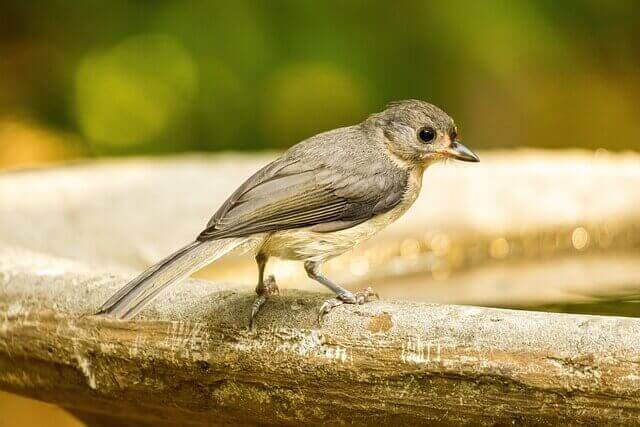
The Eastern Phoebe is a small, drab-colored bird that ranges throughout the eastern United States. This species is often seen on the ground searching for food. The range of this bird includes parts of southern Canada, and it can be spotted as far south as Florida. The Eastern Phoebe prefers to live near water sources such as lakes and streams where they can find insects, amphibians, fish and other small animals for food.
The Eastern Phoebe is an insectivore, with their diet consisting of mostly bugs but also some seeds and berries. These birds migrate south in winter for warmer weather before returning north during the spring months, when breeding.
- Frequency: 19.33%
- Color: Gray-brown upper, gray breast and underbody, white throat
- Habitat: Farmland, parks, and gardens
- Range: Southern USA and Mexico
- Size: 5.5 – 6.7″ inches long
- Weight: 16 – 21 grams
- Diet: Insects and berries
- Family: Tyrannidae
- Genus: Sayornis
Yellow-rumped Warbler

The yellow-rumped warbler’s habitat ranges from North America to Costa Rica, but is concentrated in the eastern United States and Canada. In winter, they migrate south for milder climates and better insect availability in Central America. They tend to stay away from deserts or heavily forested areas because there are not enough insects or fruit available in these regions.
The majority of their habitat is forested areas with dense undergrowth. The yellow-rumped warbler’s diet consists mainly of insects and fruit; they eat less than two percent of other food sources such as berries, nuts, seeds, grains and spiders. In addition, the bird is a skilled hunter of ground-dwelling spiders.
- Frequency: 17.81%
- Color: Yellow patches on the crown, flanks, rump & blackish-blue streaks on the back, breast, and wings
- Habitat: Deciduous forests and thickets, roadside, grasslands, backyards
- Range: U.SA, Canada, Mexico, Central America, and the Caribbean
- Size: 4.7 – 5.9″ inches
- Weight: 10 – 18 grams
- Diet: grasshoppers, gnats, aphids, caterpillars, wasps, beetles, spiders, berries,
- Family: Parulidae
- Genus: Setophaga
Related Post: How to Attract Warblers to you Yard?
Chipping Sparrow
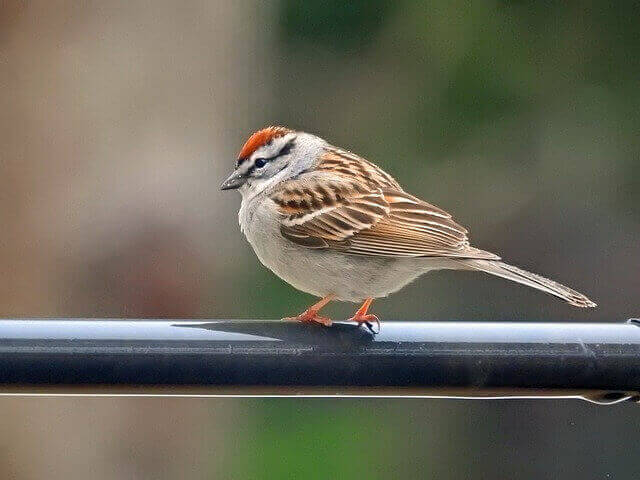
The Chipping Sparrow is a very common bird that can be found in most parts of the United States. The chipping sparrow’s range includes eastern North America, south to the Gulf Coast and west to Montana. It lives in almost any habitat from urban environments, deserts, prairies and marshes. Its diet consists mainly of insects, but also eats seeds or fruits when food is scarce.
They will often eat insects such as ants, beetles, spiders and caterpillars but also some seeds of wildflowers like ragweed or thistles. Their mating season starts early in the year when they return from their winter migration back to North America’s Northern United States.
- Frequency: 17.45%
- Color: Rust-colored upperparts, gray head, and underparts with a reddish cap on the head
- Habitat: Coniferous forests, woodland, farmland, parks, and gardens
- Range: Southern USA and Mexico
- Size: 4.7 – 5.9″ inches
- Weight: 11 – 16 grams
- Diet: Mostly seeds, spiders
- Family: Passerellidae
- Genus: Spizella
Related Post: How to Attract Sparrows to your Backyard? (Like A Pro)
Pine Warbler
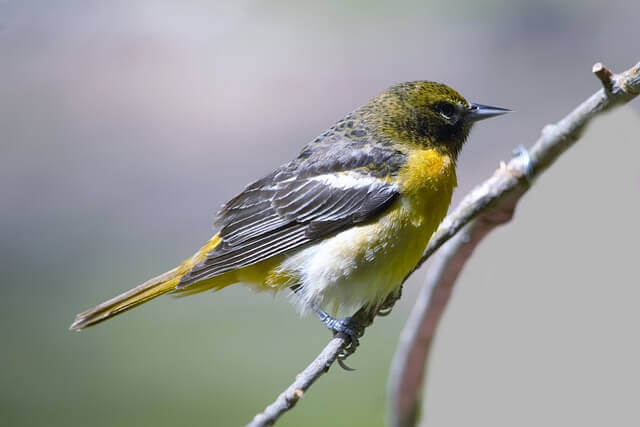
The Pine Warbler is a small songbird, weighing just over two ounces. They are found throughout the eastern United States and Canada in deciduous forests of the Eastern U.S., northern parts of Texas, as well as southern New England and Canada. Their range extends from Maine to Florida, west to Kansas and north into Ontario, Quebec and Minnesota.
Pine Warblers primarily eat insects like spiders, beetles, ants and grasshoppers; this diet provides them with enough protein for energy. Pine Warblers migrate south for winter where they can be found primarily in Louisiana or Texas with occasional sightings further eastward in Mississippi.
- Frequency: 16.88%
- Color: (Female)White belly, two white wing bars, with yellow lines over their eyes. (Male: Dark yellowish-greenupper parts and yellow throats and breast. Long pointed bill.
- Habitat: Eastern pine forests, parks, and backyards
- Range: Eastern North America, Mexico, Caribbean
- Size: 5.0 – 5.75″ inches
- Weight: approx. 12 grams
- Diet: Insects, seeds and berries
- Family: Parulidae
- Genus: Parula
Related Post: How to Attract Warblers to your Yard? (Expert Tips)
American Goldfinch
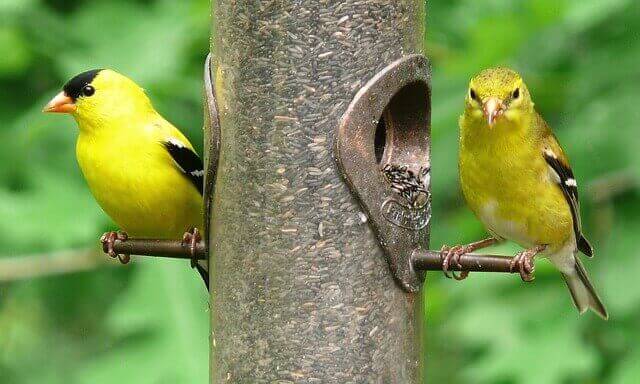
The American Goldfinches range is mostly in the northern United States and Canada. They are found year-round in most of the continental US, but their population density varies depending on winter weather conditions. The American Goldfinch is primarily a bird of open country with some trees or scattered trees such as fields, parks, yards and gardens.
It also frequents roadside vegetation along highways, tracks and rights-of-way adjacent to forests or agricultural areas. The goldfinch’s diet consists mostly of seeds, but they also eat insects like grasshoppers and crickets as well as some fruit including cherries, berries and grapes. These colorful birds migrate every year to different parts of North America depending on the weather.
- Frequency: 16.80%
- Color: Face, neck, and underside are yellow, black wings with white bars
- Habitat: Deciduous forests and thickets, roadside, grasslands, backyards, meadows
- Range: Canada, USA, and Mexico
- Size: 4.3 – 5.5″ inches length
- Weight: 12 -18 grams
- Diet: Grass, dandelions, chickweed, sunflowers and ragweed, thistle, red alder, birch, spruce seeds
- Family: Carduelinae
- Genus: Spinus
Related Post: Interesting American Goldfinch Facts You Need to Know!
These backyard birds all have a frequency of less than 16% Year-round
- American Goldfinch
- European Starling
- Common Grackle
- White-eyed Vireo
- Indigo Bunting
- White-throated Sparrow
- Ruby-throated Hummingbird
- Killdeer
- Great Egret
- Brown-headed Cowbird
- Blue-gray Gnatcatcher
- Brown-headed Nuthatch
- White-breasted Nuthatch
- Double-crested Cormorant
- Barn Swallow
- Great Crested Flycatcher
- Ruby-crowned Kinglet
Frequently Asked Questions
Are finches found in Alabama?
There are 4 species of finches that can be found throughout Alabama, they are the House Finch, Purple Finch, American Goldfinch and Lesser Goldfinch.
What birds are blue in Alabama?
Bluebirds are found in Alabama, and blue jays can be seen as well. The most famous of these is the Blue Jay, which is found throughout North America.
What is the biggest bird in Alabama?
The buteo hawk is the largest bird in Alabama. They can grow up to 2 feet tall and have a wingspan of up to 5 feet.
What is Alabama state bird?
The Alabama State Bird is the Northern Flicker. The Northern Flicker is a type of woodpecker that lives in North America and Canada. It was named as the state bird of Alabama on September 6, 1927, because it can be found all over the state.
Do ravens live in Alabama?
Yes, they do. In fact, a species of raven has been found to live exclusively in the state. This species is the white-necked raven (Corvus leucognaphalus). They are most often found in forested areas, and will occasionally inhabit woodlands or even semi-open habitats like parks and fields with scattered trees.
Do Ospreys live in Alabama?
Ospreys are migratory birds and can be found in many parts of the world. Some places they can be found include Alabama, California, Maine, Massachusetts, New York City and even a few parts of Canada. Ospreys live near bodies of water where they hunt for fish as their main food source.
Are Swallows in Alabama?
Tree Swallows are common in Alabama. They are a migratory bird that spend the winter months in warmer climates and then migrate back to their breeding grounds.


